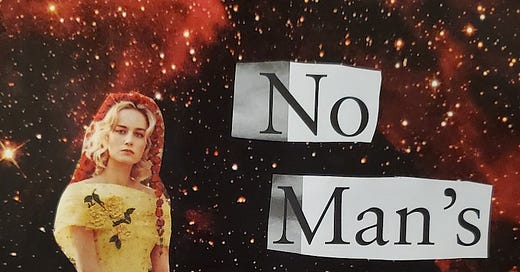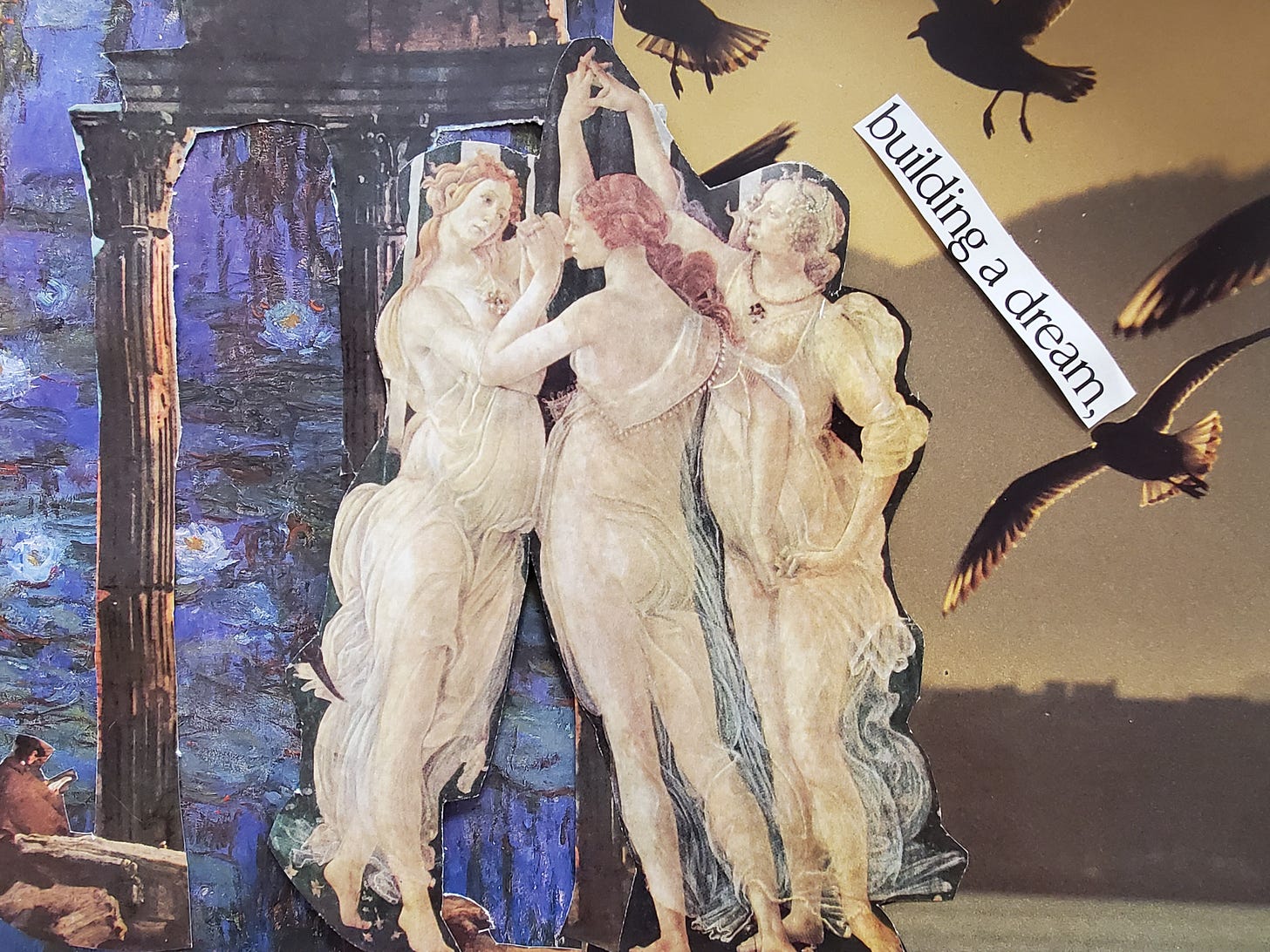Trivial art pursuits in an emergency
Collaging in a crisis, and why all of it - even the "Dumb Art" - matters

I've always been a dabbler when it comes to making art. I'll make headbands, paint canvases, or sew vintage patterns. One time, I really got into Japanese calligraphy. I can’t help it! My focus area right now is writing about fashion and interior design. I have enthusiasm for it all (even if my wallet groans after I visit my nearest-and-dearest art supply stores).
But if I ever have a really bad day, the one craft I always return to is collaging. It is genuinely pleasant to cut out shapes, to drip glue, to breathe new contexts into old images. I love the world-building of it all — to transform discarded scraps into possibilities. And it's no wonder that I like digital collaging so much here on Substack.
But it’s January, and things feel a bit glum as the thoughts clamber in my head like loose buttons. The U.S. presidential inauguration coincides with my birthday every four years. Inauguration, at least to me, has become a phrase that evokes fear and uncertainty. In the last nine Januaries, we’ve had … too much. Inaugurations, an insurrection, the pandemic, mass layoffs, and now these California wildfires. The last decade of birthdays has felt very apocalyptic, a reminder of bearing witness to multiple catastrophes.
So perhaps it’s a strange time to start a Substack to write about curtains, British bohemianism, and clothing – pursuing my version of art and beauty. It feels very trivial in These Uncertain Times. I feel guilt in writing about these topics, knowing I won’t always respond to the moment.
If I were feeling ungenerous to my own attempts, I’d call my work ‘Dumb Art’. Does anyone want to read about curtain trends when there’s multiple ongoing crises? Will I be embarrassed that this was my record of existence during this time? I struggle with thinking that whatever I want to make is worthy — of creation, time, consideration, attention. Is devoting this much thought to Dumb Art myopic vanity?
I suppose that raises the question: what is the value of art? D.W. Gotshalk attempted to answer this heady question in the aftermath of WWII in “Art and the Social Order.” According to Gotshalk, art can have extensive educational, recreational, commercial and historical value, as well as be a form of physical utility and a mode of commemoration. But it can also be medicinal:
“The fine arts can provide a tonic, lift, or restorative, especially in times of anxiety, irritation, and profound dislocation … They can bring repose and relief from the restlessness of life and can effect a catharsis of disturbing emotions, both for the percipient and for creative artist.”
I’m compelled to defend writing about trivial topics, because I think this kind of art does matter. During the pandemic I experimented with different media — collage, sewing, drawing, writing, etc — as a way to pass time. In the making process, I never thought that any of the art would be a response to its time (i.e. pandemic, politics, etc). But all of it personally matters as an homage to an era — these pieces are reflective of that time and my personal evolution.
Constance Grady also writes that these feelings about Dumb Art are valid:
“The world feels as though it is in existential danger, and to engage with anything less than that danger feels trivial. So people enjoy feeling that the art they engage with is in some way helping to save the world. But political satire is not the only way that art can help us reckon with the world. And to insist that all art must be satirically attempting to subvert the state to be worth our time, or else failing to properly subvert the state and hence in need of chastisement, is impoverishing.”
Too much of my 30s has been stolen by anxiety, and I’m not looking forward to an ongoing era where stressful politics will be at the forefront of not only the news, but so much of our daily decision-making. I am frightened of the future. But I don’t want to cede all of my creative space to that feeling.
In some ways, constant crises can be bad for art. Judy Berman notes the Trump presidency not only slashed art funding, but also took up too much oxygen in the culture.
“We know that periods of social upheaval inform art, but that isn’t the same as nurturing it … When the cultural sphere expands, when human beings have the mental and emotional energy to exercise their imaginations, when speech is free but not weaponized in the service of hate, when the range of perspectives that can be expressed in relative safety broadens—that is when art flourishes.”
Too often I find myself kneecapping my own writing for focusing on what I think is only interesting to me. The only way for me to begin creating again is to find tiny ways back in based on niche interests, look closely at them, and give them the proper air they need.

Looking deeply at simple things is essential for art, as Martin Gayford writes in “Spring Cannot Be Cancelled,” about the artist David Hockney’s pandemic years in Normandy, where he spent time illustrating the same landscapes over and over on his iPad. As Hockney himself says:
“Each time I do a still life, I get very excited and realize that there are a thousand things here I can see! Which of them shall I choose? The more I look and think about it, the more I see. These simple little things are unbelievably rich. A lot of people have forgotten that. But you can remind them.”
The sense of urgency to grapple with larger societal concerns is, at least for me, antithetical to even getting creation off the ground.
This is encouragement (for me, and from me to you) to continue making the art that interests you, even if it doesn’t respond to the urgency of the news cycle. Continue writing about “Sex and The City” (if that is your thing). Continue that podcast about your favorite rocks. Collage to your heart’s desire. And I will continue writing about the very specific things I like. We can be weird, tiny flames together.
As Grady says, “Do not apologize for caring about art. Do not apologize for engaging with art outside of the terms set by the state, even now, even now. Insist on the value of art. Insist on the value of your life.”
And as a parting call to action, I found this recent column inspiring — the 88-year-old writer and painter Frederic Tuten on “The Secret of Life is Not to be Frightened”:
“I feel at this crazy time that I’m beginning again, with a wish to not repeat myself, to not repeat any formulas for fiction or painting. I write every day. The work could be terrible; it could be nothing. I could be fooling myself. The extraordinary thing is that I look forward to doing the work. I can’t wait to get down to it.”
Extended reading:
Book Reads:
“Spring Cannot Be Cancelled: David Hockney in Normandy” by Martin Gayford
“The Hare with Amber Eyes” by Edmund de Waal. It’s a memoir about a ceramicist tracking the history of his inherited netsuke figurines, learning about his lost Jewish lineage, and the importance of preserving art during war. This passage, about a maid named Anna who preserved the netsuke from the Nazi regime under her mattress during WWII, was especially moving: “Each one of these netsuke for Anna was a resistance to the sapping of memory. Each one carried out is a resistance against the news, a story recalled, a future held onto.”
Donald Trump’s presidency was supposed to be great for art. It wasn’t | Time
Art in the time of crisis | Carnegie Museums
In defense of cultural criticism in Trump’s America | New Republic
The Secret of Life is Not to be Frightened | NYTimes (gift link)
Other reading:
Thinking about L.A. Here’s a massive roundup of ways to help, and a list of goFundMes for individual families | LA Mutual Aid; Trans Defense Fund LA
I found this essay deeply moving about losing a place and its things | Dispatches with Hollie McKay
Also this story about what people saved from the fires | The Cut
On balancing work and art | Amie’s Substack
33 ways to improve your life, Japanese style | Mr. Porter (h/t to Kottke)






